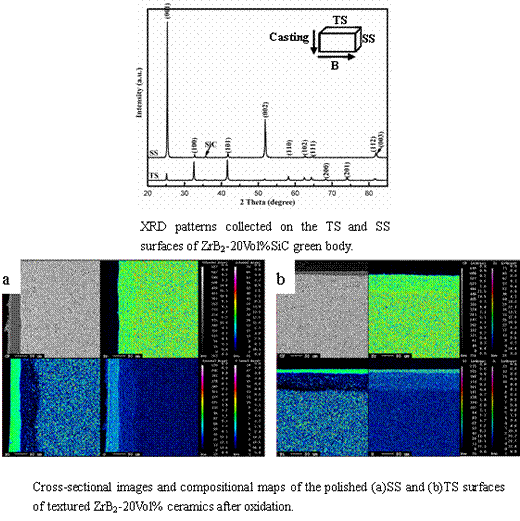Textured ZrB2-based Ultra High Temperature Ceramics
Recently, an important scientific result related to fabrications and microstructures tailoring of Ultra High Temperature Ceramics (UTHCs) was obtained by the group headed by Prof. Guo-Jun Zhang, Shanghai Institute of Ceramics, Chinese Academy of Sciences. An idea of textured UTHCs (ZrB2 and HfB2) was firstly brought forward by the group and realized by using slip casting technique under a strong magnetic field, which was collaborated with Prof. Yoshio Sakka, National Institute for Materials Science, Japan. The success of this work will further provide a new available approach to enhance the properties of UTHCs. The result was recently published in an international journal, Scripta Mater., and received good comments from the reviewers. For the paper of ZrB2-SiC (Scripta Mater., 60 [8], 615-618 (2009)), the editor, Prof. Subhash Risbud, University of California-Davis, USA, reviewed the manuscript himself and made the following comments: “The strong magnetic field applied during slip casting to create textured ZrB2-based ceramics is an interesting new direction. The innovative use of SMFA plus SPS is a strong point in this paper. Textured ceramics with better hardness and interesting anisotropic oxidation resistance are worthwhile results to report…the manuscript has enough novelty to recommend publication…”. Accordingly, the manuscript was accepted for publication in just five days after submitted to the journal. Another paper dealing with the textured HfB2-SiC ceramics (Scripta Mater., 60 [10] 913-916 (2009)), the reviewer said as follows: “The paper is of interest either for the materials investigated, or for the attempt to drive a specific microstructure texture”. A Chinese patent related to the textured UHTCs was applied (applied No: 200810205213.2) in 2008.
The transition metal diboride ceramics, zirconium diboride (ZrB2) and hafnium diboride (HfB2), are identified as the most promising candidates for the thermal protection system of hypersonic flight. However, the properties of these materials must be improved to meet the requirements for practical applications up to now. The ceramics with an orientation microstructure was considered as one of the important approaches to optimize the properties of the materials. Since both ZrB2 and HfB2 belong to hexagonal system, it means that the atomic stacking densities and characters of chemical bond on the different lattice planes would be different. It was supposed that the crystal structure characters could result in anisotropic behavior of borides crystals and could be possible to optimize the property of UHTCs along one direction by making the ceramics with oriented microstructure. The study on textured ceramics of borides was therefore carried out in the group. Based on the success of synthesis of pure ZrB2 and HfB2 powders with nearly column-like morphology and 1-1.5mm size, the strong magnetic field (12T) was applied to the slurry resulted from the powders during slip casting. The textured ceramics of ZrB2-SiC and HfB2-SiC were finally obtained by SPS sintering, in which the lotgering factors of the oriented materials were all higher than 0.9 along c direction. For textured ZrB2-SiC and HfB2-SiC ceramics, the hardness on the (001) plane perpendicular to c direction showed higher values in comparison to other directions. Besides, the SiO2 layer was easily formed on the oriented surface of the oxidized ceramics at high temperature, which would further restrain from the oxidation inside of the borides ceramics. This advantage of anisotropic oxidation resistance of the textured borides ceramics would be beneficial to exert the potential properties of the materials. These research results were firstly reported in the research field of UHTCs, which could make people to create a new approach to tailor microstructure and retrain oxidation of UHTCs.
This work was supported by the National Natural Foundation of China. The project is entitled “Phase relationship, preparation and microstructural tailoring of ultra high temperature ceramics” (Contract No. 50632070).

Reported by State Key Lab of High Performance Ceramics and Superfine Microstructure,
Shanghai Institute of Ceramics, Chinese Academy of Science



